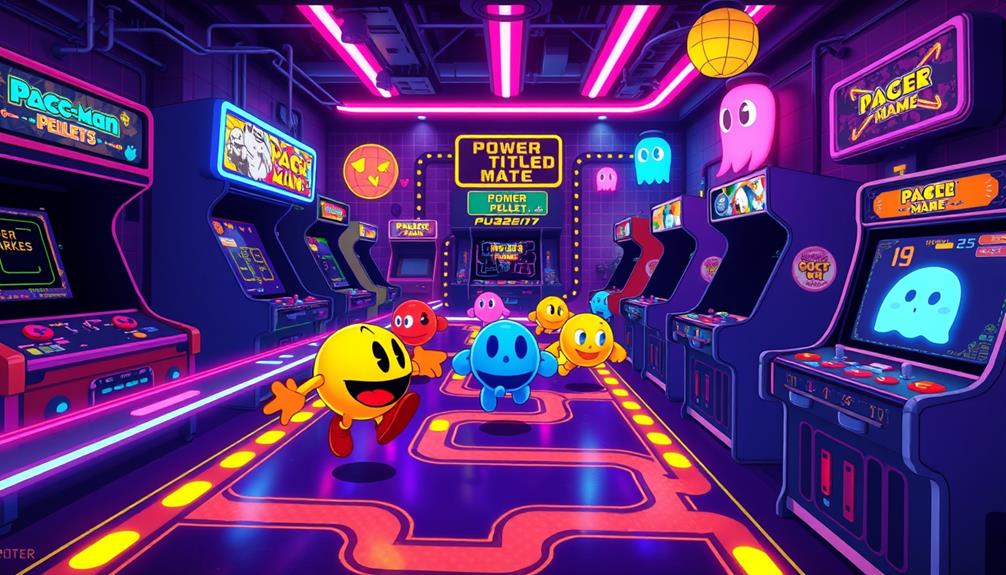Some of the original arcade games you may be familiar with are “Computer Space” and “Pong.” “Computer Space,” released in 1971, signaled a shift from mechanical games to digital ones but struggled to achieve commercial success. Then, in 1972, Atari’s “Pong” emerged, transforming the arcade industry with its straightforward gameplay and competitive nature. This set the stage for iconic classics like “Space Invaders,” “Pac-Man,” and “Donkey Kong,” which epitomized the Golden Age of arcades. Each of these games contributed to the vibrant gaming culture that continues to shape the industry today. Continue to delve deeper into the fascinating history of arcade games to uncover more intriguing aspects. The history of arcade games is brimming with innovation and creativity, as developers consistently pushed the limits of technology and gameplay. From the inception of joystick controls to the creation of multiplayer games, the arcade sector has continuously adapted to meet the desires of players. Additionally, the history of arcade games reflects the evolving tastes and trends of society, demonstrating how pop culture influences gaming. Whether through cutting-edge technology or memorable characters, the history of arcade games underscores the enduring allure of this form of entertainment.
Key Takeaways
- "Computer Space," launched in 1971, was the first arcade video game but struggled commercially despite innovative gameplay mechanics.
- "Pong," released by Atari in 1972, became the first commercially successful arcade game, known for its simple design and competitive appeal.
- "Galaxy Game," an early arcade game that showcased "Spacewar!" gameplay, was available in university settings, highlighting the emerging interest in video games.
- Taito's "Space Invaders," released in 1978, marked a significant milestone, selling over 100,000 machines and establishing the shoot 'em up genre.
- "Pac-Man," launched in 1980, became a cultural icon, attracting diverse audiences and revolutionizing gaming with its non-violent approach and engaging gameplay.
Early Coin-Operated Games
The evolution of early coin-operated games paved the way for the vibrant arcade scene we're familiar with today. In the 1900s, pinball machines emerged as a cornerstone of arcade gaming, enchanting players with their simple yet engaging gameplay. These devices set the stage for what would come next in arcade history, showcasing innovations in game design such as mechanics of pinball machines.
The first arcade game, "Computer Space," debuted in 1971, but it struggled commercially due to its complexity. Shortly after, "Pong" was released by Atari in 1972, becoming the first commercially successful arcade video game and solidifying the popularity of arcade cabinets.
As arcade gaming continued to grow, other titles like "Galaxy Game" followed, showcasing early video games in university settings. These coin-operated games not only entertained but also established a business model that would thrive in commercial arcade environments.
The Birth of Computer Space

In 1971, you witness the launch of Computer Space, the first arcade video game created by Nolan Bushnell and Ted Dabney.
Inspired by the earlier game Spacewar!, its gameplay challenges players to control a rocket ship and shoot down pesky flying saucers.
This innovative title paved the way for the development of future arcade machines, such as those featured in the best arcade machines for home game rooms.
While it didn't achieve commercial success, its impact on the gaming industry set the stage for future innovations.
Conceptual Origins and Inspiration
Born from the creative minds of Nolan Bushnell and Ted Dabney, "Computer Space" emerged as a groundbreaking innovation in 1971, marking the dawn of the arcade gaming industry. This pioneering game drew inspiration from "Spacewar!", an earlier creation that captivated tech enthusiasts at MIT in 1962.
As you explore the origins of "Computer Space," you'll see how it laid the groundwork for what would become a thriving sector of coin-operated entertainment. Notably, the evolving landscape of entertainment also saw influences from various cultural phenomena, such as astrology and attractiveness, which shaped how games were marketed and received.
Bushnell and Dabney aimed to transform gaming into a commercial venture, and they succeeded in delivering the first commercially available arcade game. Though its gameplay involved maneuvering a rocket ship to battle flying saucers, "Computer Space" faced challenges with high difficulty and complexity that limited its appeal.
Still, its release signified a significant moment in the early commercialization of video games, setting the stage for future innovations.
Distributed by Nutting Associates, "Computer Space" not only marked the beginning of the arcade gaming industry but also paved the way for iconic titles like "Pong," which followed just a year later. This evolution sparked a new era in entertainment that continues to thrive today.
Gameplay Mechanics and Challenges
Arcade games revolutionized entertainment, and Computer Space set the stage with its innovative gameplay mechanics. Released in 1971, it became the first commercially available arcade game, designed by Nolan Bushnell and Ted Dabney. You control a rocket ship, engaging in combat against flying saucers. This requires you to manage your ship's movement and firing mechanics, which can be quite challenging.
The emergence of AI-driven platforms catering to diverse preferences in adult content reflects a similar drive for personalized experiences in entertainment, showcasing how technology continually reshapes the industry AI in Adult Entertainment.
However, the game's high difficulty level posed a barrier for casual gamers, limiting its appeal and commercial success. Many found the steep learning curve intimidating, making it hard to attract a broader audience.
Despite these challenges, Computer Space showcased the potential of video gaming as a form of public entertainment. Its unique cabinet design, featuring a monitor and control panel, set a precedent for future arcade game hardware, which would become a staple in arcades.
While it didn't achieve the massive success expected, Computer Space laid the groundwork for future arcade games, illustrating how engaging gameplay mechanics could draw players into public entertainment venues. This pioneering game highlighted the intriguing possibilities of video gaming, paving the way for innovations that would follow.
Commercial Impact and Legacy
The release of Computer Space in 1971 marked a pivotal moment in gaming history, shifting the industry from traditional pinball and mechanical games to electronic video entertainment. As the first commercial arcade video game, developed by Nolan Bushnell and Ted Dabney, it introduced players to a new domain of arcade gaming.
This revolutionary shift wasn't just about entertainment; it also challenged conventional views on existence and self-identity in gaming experiences, reflecting the existential themes that resonate in contemporary discussions of meaning. Despite its innovative approach, the game faced challenges; its complex controls and high difficulty limited its commercial success, with only about 1,500 units sold.
However, Computer Space laid the groundwork for the arcade gaming industry and inspired future developers to create more accessible games. Its release sparked interest in the burgeoning field of video games, leading to the establishment of Atari.
Just a year later, the success of pioneering games like Pong transformed arcade gaming into a cultural phenomenon.
The legacy of Computer Space is undeniable; while it may not have achieved massive sales, it ignited a revolution in how people interacted with games. Its impact resonates in today's gaming landscape, reminding you that every great journey begins with a single step, even if that step is sometimes met with challenges.
Pong: The Game Changer

When you think of classic arcade games, Pong stands out due to its straightforward gameplay mechanics.
This game was pivotal in introducing competitive gaming to the masses, making it a beloved choice among fans of uplifting music.
Its simple design made it accessible to everyone, helping to shape a new gaming culture.
Let's explore how Pong not only changed the way you play but also left a lasting impact on the gaming landscape.
Gameplay Mechanics Overview
Pong revolutionized gaming with its straightforward mechanics, making it accessible to players of all ages and skill levels. This classic arcade game, released by Atari in 1972, emulated table tennis with a minimalist visual style. You control two paddles to hit a ball back and forth, creating an engaging experience that's easy to learn but hard to master.
Its appeal can be likened to the fun moments found in family photoshoot fails where unexpected antics create memorable experiences.
Here's what makes Pong's gameplay mechanics so effective:
- Simple Controls: Just move your paddle up or down to hit the ball, requiring minimal instruction.
- Fast-Paced Action: The gameplay encourages quick reflexes, keeping players on their toes.
- Competitive Element: You can challenge friends or the machine, fostering a spirit of competition.
- Endless Replayability: Each match feels unique, making you want to play just one more game.
Pong's commercial success was staggering, generating over US$40 in daily revenue per machine. This not only paved the way for future arcade games but also cemented Pong's status as a cultural icon in gaming history.
Its gameplay mechanics laid the foundation for countless other games, ensuring its place in the hearts of players everywhere.
Cultural Impact Analysis
Arcade gaming wouldn't be what it's today without the groundbreaking impact of Pong. Released by Atari in 1972, Pong became the first commercially successful arcade video game, raking in over US$40 daily per machine. Its simple mechanics attracted a diverse audience, making it a staple in the arcade industry and establishing arcade gaming as a mainstream entertainment option.
The game's cultural significance is evident; it not only sparked a surge in arcade game production but also led to numerous clones, fueling the industry's rapid growth. The evolution of celebrity culture and events, such as the recent Met Gala extravaganza, showcases how entertainment has transformed over the decades, paralleling the rise of arcade gaming.
Beyond its commercial success, Pong played a pivotal role in shaping gaming history. The Smithsonian Museum even recognized its importance by featuring an original machine, underscoring its lasting legacy.
Additionally, Pong set the stage for competitive gaming environments and tournaments, effectively laying the groundwork for the esports we're aware of today.
In essence, Pong's influence transcended its gameplay, transforming how people engage with games and each other. By paving the way for future innovations in commercial video games, Pong undeniably changed the landscape of gaming forever.
Rise of the Arcade Phenomenon

The rise of the arcade phenomenon transformed entertainment in the early 1970s, enchanting audiences with innovative gaming experiences. It all kicked off with "Computer Space," the first commercially available arcade video game, launched in 1971, inspired by the 1962 classic "Spacewar!"
But it was in 1972 that Atari's "Pong" hit the scene, skyrocketing the popularity of arcade gaming. Some machines raked in over $40 daily, proving the potential of this new form of entertainment. This period showcased the importance of nurturing an imaginative mindset as developers sought to create engaging and memorable gaming experiences.
Key milestones fueled this burgeoning industry:
- Taito's "Space Invaders," released in 1978, sold over 100,000 machines in Japan that year.
- The Golden Age of Arcades, spanning 1978 to 1983, saw the rise of iconic games like "Pac-Man" and "Donkey Kong."
- By January 1982, more than 13,000 arcades were operating in the U.S.
- The arcade industry peaked in the 1980s, driven by technological innovations and gameplay advancements.
This era not only shaped the gaming landscape but also left an indelible mark on pop culture, laying the foundation for the future of entertainment.
The Golden Age of Arcades

During the Golden Age of Arcades, a remarkable shift occurred in the gaming landscape, enchanting players with vibrant graphics and engaging gameplay. Spanning from 1978 to 1983, this era was ignited by Taito's Space Invaders, which established the shoot 'em up genre and sold over 100,000 machines in Japan by the end of 1978.
The success of iconic games like Pac-Man and Donkey Kong further defined this golden age. Pac-Man, released in 1980, became the best-selling arcade game with about 400,000 cabinets sold by 1982, appealing to a wide audience with its non-violent mascot. Donkey Kong, introduced in 1981, launched the platformer genre and made Mario a household name.
As arcades flourished, over 13,000 establishments were reported in the U.S. by early 1982, with daily profits from popular machines exceeding $400. This period also marked the rise of competitive gaming, with video game tournaments gaining traction, paving the way for today's esports scene.
| Game Title | Genre | Release Year |
|---|---|---|
| Space Invaders | Shoot 'em up | 1978 |
| Pac-Man | Maze/Action | 1980 |
| Donkey Kong | Platformer | 1981 |
Iconic Games of the 80s

As you think back to the 80s arcade scene, several pioneering titles stand out, shaping both gaming and culture. Unique party options enhance celebrations, just as games like Pac-Man and Donkey Kong not only entertained but also influenced social dynamics, attracting a diverse range of players.
interactive games for guest engagement can be likened to the way these arcade games created social interactions among players.
Let's explore how these iconic games left a lasting mark on the arcade landscape and beyond.
Pioneering Titles of 1980s
In the vibrant landscape of arcade gaming, the pioneering titles of the 1980s stand out for their groundbreaking gameplay and cultural impact.
These arcade video games not only defined genres but also captivated players worldwide. Let's take a closer look at some iconic titles:
- Pac-Man: Released in 1980, it became a cultural icon, considerably boosting female gamers' participation.
- Donkey Kong: Debuting in 1981, it introduced Mario and established the platformer genre, setting a lasting legacy.
- Asteroids: Although launched in 1979, it soared in popularity during the 80s, known for its vector graphics and high earnings.
- Frogger: Released in 1981, it brought a unique obstacle navigation mechanic that made it a beloved classic.
Additionally, Space Invaders, which debuted in 1978, marked the beginning of the shoot 'em up genre and was a cultural phenomenon.
These games not only captured the imaginations of players but also laid the foundation for the evolution of arcade gaming.
With their innovative gameplay and engaging mechanics, they paved the way for generations of gamers to come.
Cultural Impact of Arcades
While the 1980s witnessed the rise of iconic arcade games, their cultural impact extended far beyond mere entertainment. Titles like Space Invaders, Pac-Man, and Donkey Kong revolutionized the gaming landscape, creating a shared social experience among players.
Space Invaders introduced the concept of high scores, making competition a central aspect of gameplay. Pac-Man broke barriers with its non-violent approach, attracting a diverse audience and becoming a cultural phenomenon, selling around 400,000 cabinets by 1982.
Donkey Kong not only introduced Mario, a character who'd dominate gaming for decades, but also established the platformer genre, further cementing arcades as cultural icons.
The excitement surrounding these arcade games paved the way for video game tournaments in the 1980s. Competitions featuring Pac-Man and Donkey Kong helped foster a competitive spirit, setting the stage for modern esports.
Organizations like Twin Galaxies emerged, tracking high scores and creating a community where players could showcase their skills. The cultural impact of arcades in the 80s shaped the future of gaming, influencing how we interact, compete, and engage with video games today.
Technological Innovations in Arcades

Technological innovations have transformed arcade games from simple pastimes into immersive experiences. The journey began with the first commercially available arcade video game, "Computer Space," in 1971, but it was Atari's "Pong" in 1972 that truly popularized arcade gaming with its simple mechanics. As technology advanced, so did the complexity and engagement of the games.
Key innovations that shaped arcade gaming include:
- Introduction of microprocessors in the early 1970s, enhancing graphics and gameplay mechanics.
- Persistent high scores introduced by Taito's "Space Invaders" in 1978, encouraging competition among players.
- Interactive audio that revolutionized in-game soundscapes, making gameplay more engaging.
- 3D polygon graphics showcased by Atari's "I, Robot" in 1984, setting a new standard for visual fidelity.
These technological advancements not only improved the arcade experience but also paved the way for future innovations, blending entertainment with cutting-edge technology.
As these features evolved, players found themselves captivated by richer graphics and more intricate gameplay, marking a significant shift from the simple mechanics of earlier games to the immersive worlds we enjoy today.
The Impact of Home Consoles

Home consoles revolutionized the gaming landscape in the late 1980s and early 1990s, drawing players away from arcades and into their living rooms. The Nintendo Entertainment System (NES) played a pivotal role, making it easier for you to enjoy games at home without the need for quarters.
As you found the convenience of home gaming appealing, arcade revenues began to decline drastically.
By the late 1990s, many arcades faced closure as home consoles offered longer narratives and more complex gameplay. Titles like "Mortal Kombat" and "Street Fighter II," once arcade hits, became staples in home gaming. You could now replicate that arcade experience in your own space, competing against friends or even online.
The competitive nature of home gaming further diminished the arcade scene, making it less attractive for you to visit physical locations.
Although traditional arcades suffered, nostalgia for those classic games sparked a resurgence in retro-themed experiences. This blend of arcade and home gaming allows you to relive the excitement of your favorite titles while enjoying the comforts of home.
Ultimately, home consoles greatly reshaped how and where you experience gaming.
Resurgence of Arcade Culture

Arcades are making a comeback, driven by a wave of nostalgia for classic games and a desire for social gaming experiences.
You'll find that adult-targeted arcades, or "barcades," are popping up everywhere, offering a blend of retro gaming and social environments. This resurgence in arcade culture also highlights the importance of community and competition.
Here are some key elements fueling this revival:
- Classic Games: Titles like Pac-Man and Street Fighter are still drawing crowds.
- Competitive Gaming: Tournaments are being held, tracking high scores just like in the early arcade days.
- Family Entertainment Centers: These venues combine arcade gaming with options like bowling and dining, appealing to families and groups.
- Modern Technology: VR and AR innovations are breathing new life into beloved classics.
Mobile adaptations show that the demand for these nostalgic experiences is high, with millions downloading games like Pac-Man.
Future of Arcade Gaming

Looking ahead, the future of arcade gaming is shaping up to be an exciting blend of innovation and nostalgia. As technology evolves, you'll see more arcades embracing virtual reality (VR) and augmented reality (AR) to enhance your gaming experience. This shift not only attracts a new generation of players but also revitalizes classic arcade games with a modern twist.
Nostalgia-driven venues, often called "barcades," are rising in popularity, combining your favorite classic games with a social atmosphere and drinks. These spaces cater to adults who fondly remember their arcade days while enjoying a night out.
Despite the challenges posed by home gaming and mobile platforms, competitive gaming events and esports tournaments are breathing new life into arcade-style play. They present fresh revenue opportunities for operators enthusiastic to adapt.
Additionally, there's been a noticeable shift toward redemption games like claw machines, reflecting changing consumer preferences. Major manufacturers like Raw Thrills and LAI Games continue to innovate, blending classic gameplay with cutting-edge technology, ensuring that arcade gaming remains a vibrant and engaging experience for everyone.
Frequently Asked Questions
What Were the First Arcade Games?
You might find that the first arcade games include titles like Computer Space and Pong. These early games paved the way for future innovations, shaping the gaming landscape you know and enjoy today.
Which Came First, Tetris or Pac-Man?
You'll find that Pac-Man came first in 1980, enchanting players with its maze chase. Tetris followed in 1984, challenging you to fit falling blocks. Both games left unforgettable marks on gaming history and culture.
Which Came First, Donkey Kong or Pacman?
You'll find that Pac-Man was released first in 1980, while Donkey Kong followed in 1981. Both games markedly impacted the arcade landscape, shaping gaming culture and introducing memorable characters that still resonate today.
What Was the First 3D Arcade Game?
You'd find that "I, Robot," released by Atari in 1984, was the first fully 3D arcade game. It introduced innovative isometric perspectives and joystick controls, despite struggling commercially. Its influence shaped future gaming technology considerably.
Conclusion
Arcades have evolved from simple coin-operated machines to vibrant hubs of entertainment, where flashing lights and catchy sounds create a unique atmosphere. You've witnessed the rise of classics like Pong and the resurgence of arcade culture, reminding you of the thrill of competition and camaraderie. As technology advances and home consoles become more prevalent, arcades still hold a special place in your heart, promising a future where nostalgia and innovation collide, making every visit an unforgettable experience.









